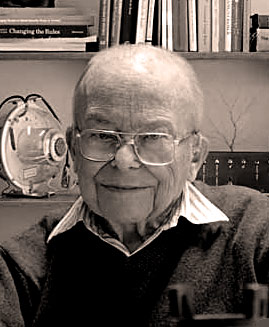In Memoriam: Pief Panofsky
 Wolfgang K.H. Panofsky, renowned Stanford physicist and arms control advocate, dies at 88
Wolfgang K.H. Panofsky, renowned Stanford physicist and arms control advocate, dies at 88
Wolfgang "Pief" Panofsky, professor of physics at Stanford University and Director Emeritus of the Stanford Linear Accelerator Center (SLAC), died of a heart attack in Los Altos, California, on Monday, September 24. He was 88 years old.
Panofsky was a renowned particle physics researcher, an accelerator builder and an administrator of basic research. In parallel with his science career, he pursued two other interests of interrelated historical significance: nuclear arms control and international peace and security.
"The world has lost a truly great man," said Persis Drell, acting director of SLAC. "Pief's impact on particle physics was enormous, but, in addition, everyone will remember him for his unflinching integrity, personal warmth and desire to fight for the principles he believed in."
Panofsky was awarded many honors during his lifetime, most notably the National Medal of Science in 1969 and the U.S. Department of Energy's Enrico Fermi Award in 1979.
Born in Berlin on April 24, 1919, son of the famed art historian Erwin Panofsky, he arrived in the United States in 1934 and became a naturalized citizen in 1942. He graduated from Princeton University in 1938, received his Ph.D. in physics from the California Institute of Technology in 1942 and served as consultant to the Manhattan Project, helping build the first atomic bomb during World War II.
In 1945 Panofsky began work as a staff physicist at the Radiation Laboratory at the University of California, Berkeley, and was named associate professor of physics in 1948. In 1951 he joined Stanford as a full professor, directing its High Energy Physics Laboratory until 1961. When a major new project to build a two-mile linear electron accelerator began in that year, Panofsky assumed its leadership and became the first director of SLAC, a post he held until retiring in 1984.
At Berkeley, Panofsky and physicist Jack Steinberger were the first to isolate the neutral pi meson, one of the subatomic particles predicted by theorists to account for the strong force binding atomic nuclei. While at Stanford, he led a series of experiments that used high-energy electrons and photons to examine the structure and behavior of the proton.
Panofsky was a member of the President's Science Advisory Committee in the Eisenhower, Kennedy and Johnson Administrations. He advised the U.S. Atomic Energy Commission and the Department of Energy on their nuclear weapons and arms control programs. In the 1980s, he was an outspoken critic of the "Star Wars" anti-missile program. After his retirement, he was an active member of the National Academy of Sciences' Committee on International Security and Arms Control, serving as its Chairman from 1985 to 1993.
Panofsky was a Fellow of the American Physical Society and served as its president in 1974. He was also a member of the National Academy of Sciences as well as a foreign member of the Chinese, French, Italian and Russian scientific academies.
"Pief Panofsky's contributions to SLAC and the field of physics have certainly earned him a place in Stanford's pantheon of scholars," said Stanford Provost John Etchemendy. "But it is equally important to note that his work on nuclear arms control earned him a reputation not just as a scientist, but as a patriot whose life will continue to influence and inspire us for generations to come."
Panofsky is survived by his wife, Adele, and five children: Richard, Margaret, Edward, Carol and Steven.